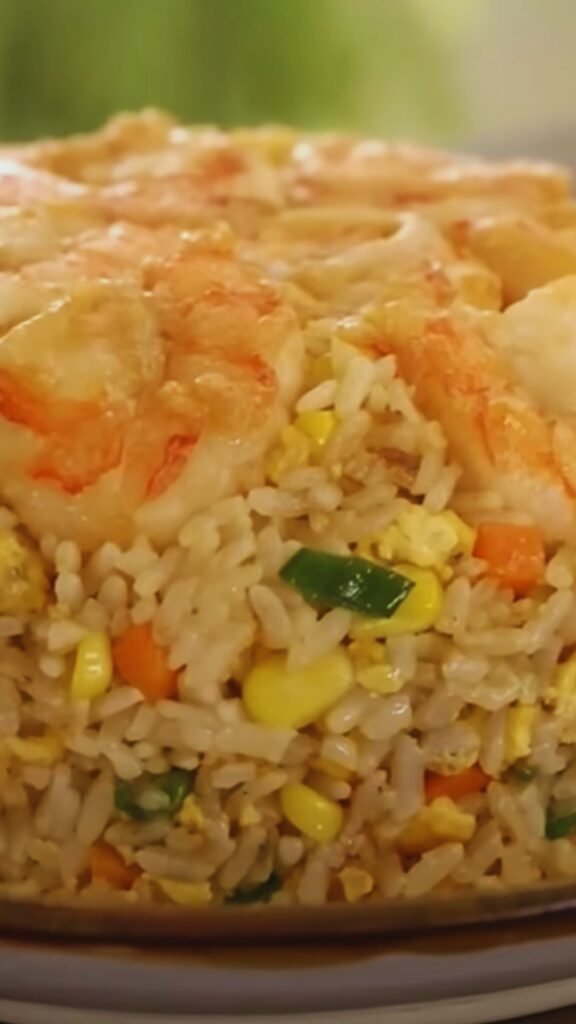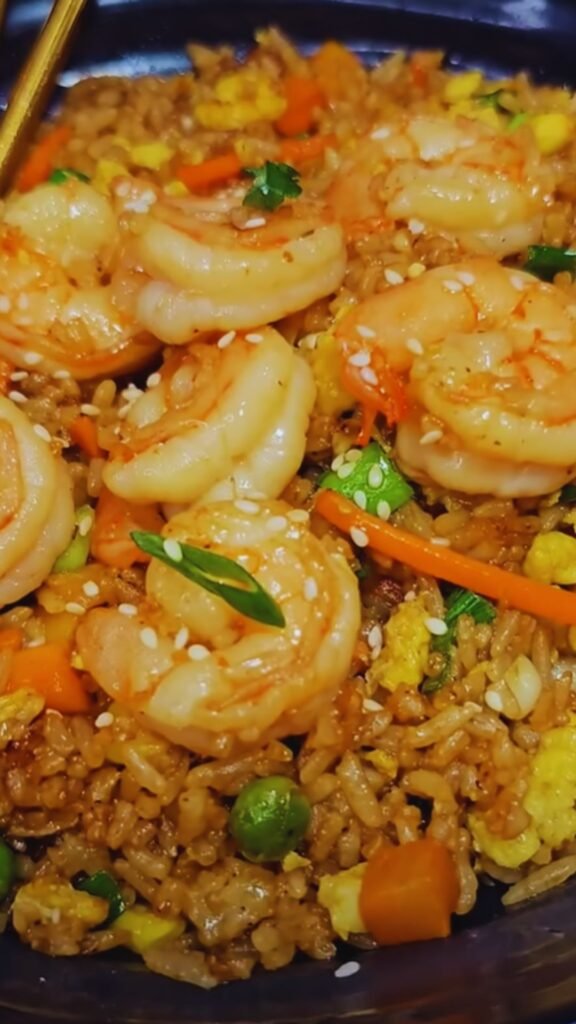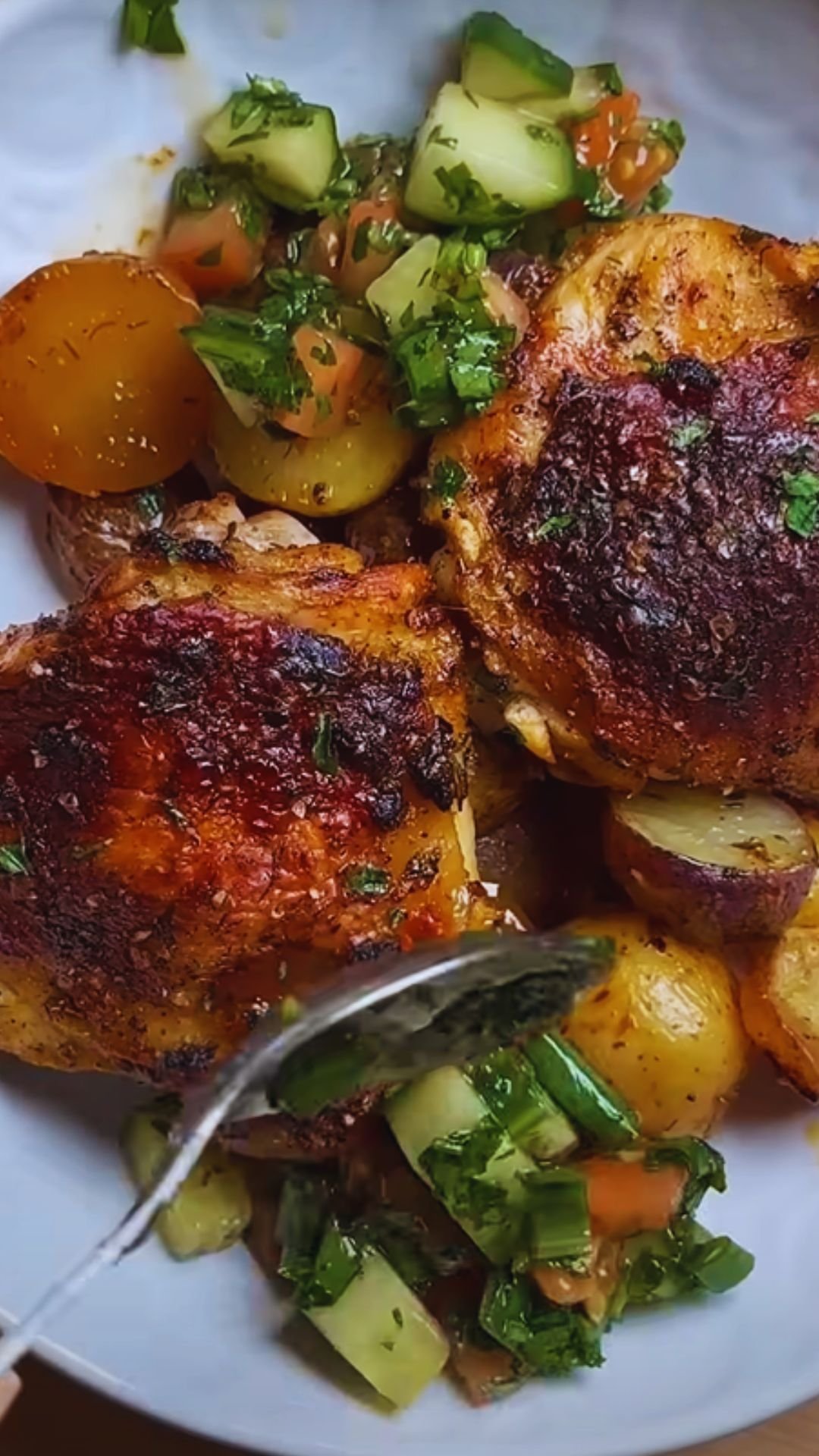Have you ever found yourself staring into your refrigerator at 6 PM, wondering what on earth you’re going to make for dinner? I certainly have. That’s why I’m sharing my favorite rescue recipe: Easy Shrimp Fried Rice. This dish has saved countless weeknight dinners in my household, transforming leftover rice and a handful of ingredients into something truly delicious in just 15 minutes.
What makes this recipe special isn’t fancy techniques or exotic ingredients—it’s the perfect balance of simplicity and flavor. I’ve refined this recipe over years of making it for my family, and now I can practically prepare it with my eyes closed. The beauty of fried rice is its versatility: once you master the basic technique, you can adapt it to whatever you have on hand.
Why This Recipe Works
There’s a reason why fried rice is a staple in so many households around the world. When done right, it hits all the marks: it’s quick, satisfying, nutritious, and incredibly adaptable. My shrimp version elevates the humble fried rice with protein-rich seafood that cooks in minutes.
The secret to truly outstanding fried rice lies in a few key principles:
- Using cold, day-old rice prevents mushiness
- High heat and quick cooking preserves the perfect texture
- A hot wok or skillet creates that coveted “wok hei” (breath of the wok)
- Minimal but purposeful seasoning lets each ingredient shine
I’ve designed this recipe to work even if you don’t have a professional kitchen setup. A regular skillet works perfectly well if you don’t have a wok, and you can still achieve excellent results with fresh rice if you don’t have leftovers (I’ll show you a quick method to dry it out).
Ingredients You’ll Need
For 4 generous servings, gather:
| Ingredient | Amount | Notes |
|---|---|---|
| Large shrimp | 1 pound (450g) | Peeled and deveined, tails removed |
| Cooked rice | 4 cups | Day-old or properly cooled fresh rice |
| Eggs | 3 large | Lightly beaten |
| Carrots | 2 medium | Diced into small cubes (about 1 cup) |
| Frozen peas | 3/4 cup | No need to thaw |
| Green onions | 4-5 stalks | Whites and greens separated, thinly sliced |
| Garlic | 3 cloves | Minced |
| Fresh ginger | 1 tablespoon | Grated or finely minced |
| Neutral oil | 3-4 tablespoons | Divided (canola, vegetable, or peanut) |
| Soy sauce | 3 tablespoons | Low-sodium recommended |
| Sesame oil | 2 teaspoons | For finishing |
| Salt and pepper | To taste | Start with 1/4 teaspoon of each |
Optional Enhancements
| Ingredient | Amount | Purpose |
|---|---|---|
| Oyster sauce | 1 tablespoon | Adds umami richness |
| White pepper | 1/4 teaspoon | More aromatic than black pepper |
| Mirin or rice vinegar | 1 teaspoon | Adds subtle sweetness or tang |
| Red pepper flakes | To taste | For heat |
| Toasted sesame seeds | 1 tablespoon | For garnish and texture |
Essential Equipment
You don’t need fancy tools, but these items will make preparation easier:
- Large wok or 12-inch skillet (non-stick works well for beginners)
- Wooden spoon or wok spatula
- Sharp knife for prep work
- Small bowls for organizing prepped ingredients

Preparation Steps
Prepare Your Rice
Perfect fried rice starts with properly prepared rice. If you’re using freshly cooked rice, here’s how to get it ready:
- Cook rice according to package instructions, but use about 10% less water than called for
- Once cooked, spread rice on a baking sheet in a thin layer
- Let it cool completely at room temperature (about 30 minutes)
- For even better results, refrigerate uncovered for 1-2 hours after cooling
If using leftover rice:
- Break up any clumps with your fingers before cooking
- If the rice is in one solid mass, rinse your hands with cold water and gently separate the grains
Prep Your Ingredients
The key to stress-free cooking is having everything ready before you heat the wok:
- Peel and devein shrimp if not already done, pat dry with paper towels
- Dice carrots into small, uniform pieces (about 1/4 inch)
- Measure out frozen peas
- Slice green onions, separating whites from greens
- Mince garlic and ginger
- Crack eggs into a bowl and beat lightly
- Combine soy sauce and any optional liquid seasonings in a small bowl
Cooking Method
Now for the fun part! The actual cooking process moves quickly, so stay attentive:
- Heat your wok or skillet: Place over high heat until smoking slightly
- Cook the shrimp: Add 1 tablespoon oil, then add shrimp in a single layer
- Cook for 1-2 minutes per side until pink and just cooked through
- Remove to a plate and set aside
- Cook the eggs: Add another tablespoon of oil
- Pour in beaten eggs
- Let set for 10 seconds, then scramble gently until just set but still moist
- Remove to the plate with shrimp
- Sauté aromatics: Add remaining oil
- Add white parts of green onions, garlic, and ginger
- Stir-fry for 30 seconds until fragrant (don’t let garlic burn)
- Add vegetables: Toss in diced carrots
- Stir-fry for 1-2 minutes until starting to soften
- Add frozen peas and cook for 30 seconds
- Incorporate rice: Add rice to the wok
- Break up any remaining clumps with your spatula
- Toss everything together, spreading rice across the cooking surface
- Let it cook undisturbed for 30 seconds to develop a slight crust, then stir
- Repeat this process 2-3 times
- Season the rice: Pour soy sauce mixture around the edges of the wok
- Quickly toss everything to distribute the seasoning evenly
- Return protein to wok: Add back the shrimp and eggs
- Gently fold everything together
- Cook for 1-2 minutes to reheat the proteins
- Finish the dish: Turn off heat
- Drizzle with sesame oil
- Add green parts of onions
- Toss once more to incorporate
And just like that, dinner is served!
Common Mistakes to Avoid
Even experienced cooks can fall into these traps:
| Mistake | Problem It Causes | How to Avoid It |
|---|---|---|
| Using wet rice | Sticky, mushy fried rice | Use day-old or properly cooled rice |
| Overcrowding the pan | Steamed rather than fried food | Cook in batches if needed |
| Not prepping ingredients | Chaotic cooking, uneven results | Do all prep before heating the wok |
| Cooking over low heat | Soggy texture, missing “wok hei” | Use the highest heat your stove allows |
| Over-seasoning | Overpowers the natural flavors | Start with less, you can always add more |
| Overcooking shrimp | Tough, rubbery texture | Cook just until pink and opaque |
Serving Suggestions
I love to serve this shrimp fried rice as a complete one-dish meal, but if you’re looking to round out your dinner, consider these accompaniments:
- Simple cucumber salad dressed with rice vinegar and sesame oil
- Steamed or stir-fried bok choy
- Hot and sour soup as a starter
- Fresh fruit like mango or pineapple for dessert
- Sparkling water with lime (refreshing with the savory flavors)
- Iced green tea

Storage and Reheating Tips
Made too much? Lucky you! Here’s how to enjoy the leftovers:
- Refrigerate promptly in an airtight container for up to 2 days
- Freeze individual portions in freezer-safe containers for up to 1 month
- Reheat in a skillet with a splash of water to restore moisture
- Microwave covered with a damp paper towel to prevent drying out
Variations to Try
The beauty of fried rice is its adaptability. Once you master the basic technique, try these variations:
Protein Swaps
- Diced chicken thighs (cook for 4-5 minutes until done)
- Thinly sliced beef (cook for 2-3 minutes for medium)
- Tofu cubes (press first, then pan-fry until golden)
- Leftover roast pork or char siu
Vegetable Options
- Diced bell peppers add sweetness and color
- Snow peas provide crunch and freshness
- Corn kernels bring natural sweetness
- Diced zucchini adds volume with fewer calories
- Edamame increases protein content
Regional Inspirations
- Thai-style: Add fish sauce, lime juice, and fresh herbs
- Korean-inspired: Mix in kimchi and gochujang
- Indonesian: Incorporate sweet soy sauce (kecap manis) and sambal
- Hawaiian: Include diced pineapple and ham
Healthier Adaptations
Want to make this dish even more nutritious? Try these modifications:
- Use brown rice instead of white for added fiber
- Increase the vegetable-to-rice ratio for fewer calories
- Reduce oil by using a good quality non-stick pan
- Add cauliflower rice for a lower-carb option (mix with regular rice 50/50)

Troubleshooting
| Problem | Possible Cause | Solution |
|---|---|---|
| Rice sticking together | Too wet or freshly cooked | Spread on baking sheet to dry before using |
| Bland flavor | Under-seasoned or not enough salt | Add a splash more soy sauce and a pinch of salt |
| Vegetables too crunchy | Not cooked long enough | Add 1-2 tablespoons water and cover briefly to steam |
| Shrimp tough and rubbery | Overcooked | Cook just until pink; they’ll continue cooking when returned to the wok |
| Everything tastes the same | Ingredients cut too small | Keep pieces distinct and add a finishing acid like lime juice |
| Too salty | Too much soy sauce | Balance with a small amount of sugar or add more rice |
Q&A Section
Q: Why does my rice always stick together when I try to make fried rice?
This usually happens when the rice is too fresh or wet. Ideally, use rice that was cooked the day before and refrigerated overnight. This allows the grains to dry out and firm up. If you need to make fried rice with freshly cooked rice, spread it on a baking sheet in a thin layer and let it cool completely. You can even place it in the freezer for 15-20 minutes to help remove excess moisture.
Q: Can I use a different seafood if I don’t have shrimp?
Absolutely! Fried rice works wonderfully with many types of seafood. Try bite-sized pieces of firm white fish, scallops (sliced in half if large), or even canned tuna (drained well). Just remember that different seafood will have different cooking times—fish generally cooks faster than shrimp, while scallops might take a little longer.
Q: Is it possible to make this dish ahead of time for a party?
Yes, but with some caveats. Fried rice is at its absolute best immediately after cooking, when the rice has crispy edges and the vegetables maintain their texture. If you need to make it ahead, I recommend preparing all ingredients and even cooking the shrimp and eggs in advance. Store everything separately, then quickly stir-fry it all together just before serving. If you must make the entire dish ahead, undercook it slightly so it doesn’t become mushy when reheated.
Q: My family doesn’t like spicy food. How can I add flavor without heat?
Focus on aromatics and umami-rich ingredients instead of chili. Increase the amount of garlic and ginger, add a dash of oyster sauce, or incorporate five-spice powder for depth without heat. A sprinkle of MSG (if you’re comfortable using it) can also boost savory flavors without adding spiciness. Fresh herbs like cilantro added at the end provide brightness without heat.
Q: How can I make this dish vegetarian?
It’s easy to transform this into a vegetarian delight! Simply omit the shrimp and double up on vegetables. For protein, consider adding cubed firm tofu (press it first and pan-fry until golden), edamame, or cashews. You might also want to use vegetarian oyster sauce (made from mushrooms) instead of regular oyster sauce for that umami boost.
Q: My rice always turns out mushy instead of having separate grains. What am I doing wrong?
Three things could be causing this: your rice might be too wet to begin with, your wok might not be hot enough, or you might be overcrowding the pan. Make sure your rice is cold and dry before starting, heat your wok until it’s smoking slightly before adding ingredients, and consider cooking in batches if you’re making a large amount.
Q: Can I use minute rice or instant rice for this recipe?
While traditional long-grain rice produces the best results, you can use instant rice in a pinch. The texture won’t be quite the same, but it can still make a tasty meal. Cook the instant rice according to package directions, but reduce the water slightly. Then spread it out to cool completely before using. The final dish might be slightly softer than traditional fried rice, but the flavors will still be delicious.
Q: How do I know when the shrimp are properly cooked?
Perfectly cooked shrimp turn from gray and translucent to pink and opaque. They also curl into a loose “C” shape. If they curl into a tight “O” shape, they’re overcooked. It typically takes just 1-2 minutes per side, depending on their size. Remember that they’ll cook a bit more when you add them back to the wok later, so it’s better to slightly undercook them initially.
Final Thoughts
I believe that everyone deserves to have a few reliable, delicious recipes in their back pocket that can be prepared even on the busiest days. This Easy Shrimp Fried Rice has been that recipe for me—turning leftover ingredients into something my family consistently enjoys and requests.
The beauty of cooking is that it doesn’t have to be complicated to be good. Sometimes the most satisfying meals come from simple techniques applied well. So the next time you find yourself with leftover rice and a bag of frozen shrimp, remember this recipe. It might just save your dinner hour, too.
Happy cooking, and remember—the best fried rice comes from making it your own. Don’t be afraid to adapt this recipe to suit your family’s preferences or whatever ingredients you have on hand. That’s what makes cooking at home so rewarding.


